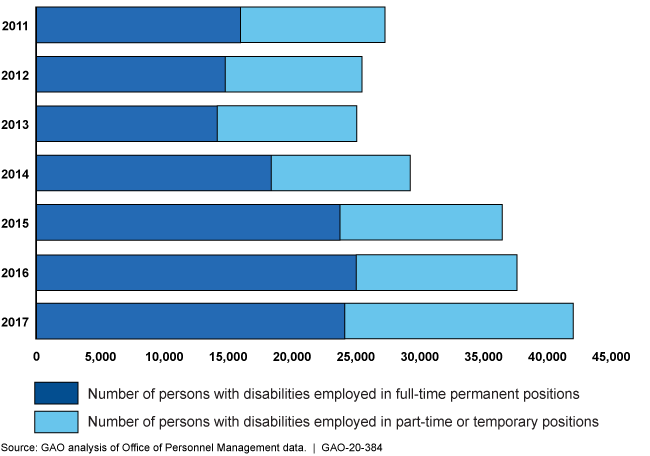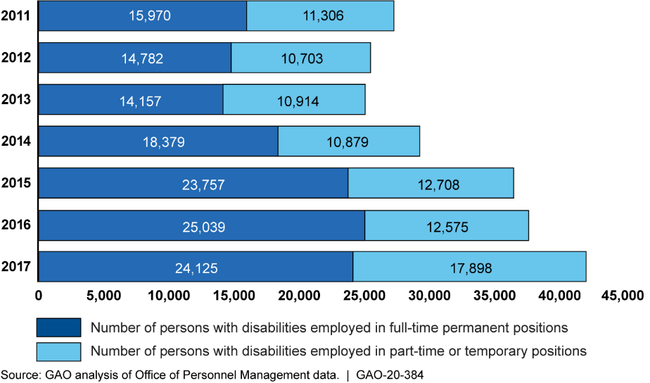Disability Employment: Hiring Has Increased but Actions Needed to Assess Retention, Training, and Reasonable Accommodation Efforts
Fast Facts
We looked at federal agencies’ efforts to hire and retain individuals with disabilities.
Agencies hired about 143,600 persons with disabilities from 2011-2015—exceeding the federal target of 100,000. Agencies made an additional 79,600 hires in 2016 and 2017.
About 39% of those with disabilities hired in 2011-2017 stayed less than a year, compared to about 43% of those without disabilities. About 60% of hires—both those with and without disabilities—stayed less than 2 years.
We made 6 recommendations, including that the Office of Personnel Management track and report retention data of employees with disabilities to help determine why they leave.
The federal government generally increased hiring of persons with disabilities, fiscal years 2011 through 2017

Bar chart showing number of persons with disabilities employed in full-time permanent positions and part-time or temporary positions
Highlights
What GAO Found
Approximately 143,600 persons with disabilities were hired during 2011 through 2015—plus an additional 79,600 hires in 2016 and 2017—across the 24 Chief Financial Officers Act agencies, exceeding the stated goal of 100,000 by 2015.
The Federal Government Generally Increased Hiring of Persons with Disabilities, Fiscal Years 2011 through 2017

About 39 percent of individuals with disabilities hired during 2011 through 2017 stayed less than 1 year and approximately 60 percent stayed less than 2 years. Of the total individuals without disabilities hired during that same time period, approximately 43 percent stayed less than 1 year and approximately 60 percent stayed less than 2 years.
Although targeted data tracking and analyses could help pinpoint root causes contributing to departure rates, the Office of Personnel Management (OPM) does not track or report retention data on disabled employees. Doing so, and making such data available to agencies would facilitate more comprehensive analyses of the retention of employees with disabilities and identify needed improvements.
Officials at three agencies GAO examined—Department of Justice (DOJ), Small Business Administration (SBA), and Social Security Administration (SSA)—used various practices to increase hiring, such as training staff on Schedule A—a commonly used hiring authority to employ individuals with disabilities. However, the agencies neither assess the impact of training nor how it relates to contributing to performance goals of increasing the number of disabled hires.
Agencies are expected to track performance related to providing reasonable accommodations. The selected agencies reported having processes in place for receiving reasonable accommodations requests, but only SSA has procedures for obtaining feedback from employees after an accommodation is provided. Without such feedback, DOJ and SBA are limited in their ability to assess the continued effectiveness of reasonable accommodations provided to employees.
Why GAO Did This Study
Federal agencies are required to provide equal opportunity to qualified individuals with disabilities in all aspects of federal employment.
GAO was asked to examine agencies' efforts to increase the employment of individuals with disabilities. Among other objectives, this report examines: (1) the extent to which agencies met the 2010 federal goal to hire an additional 100,000 individuals with disabilities by 2015, and the retention rates of those employees between 2011 and 2017; and (2) practices selected agencies used to increase hiring and retention of individuals with disabilities.
GAO analyzed data and documents from OPM and interviewed agency officials. GAO interviewed officials from DOJ, SBA, and SSA about their efforts to enhance employment opportunities for disabled persons. GAO selected these three agencies because they represent a range of agency size and relatively high or low percentages of total employees with disabilities.
Recommendations
GAO is making 6 recommendations: OPM should track and report retention data; DOJ, SBA, and SSA should assess training impacts; and DOJ and SBA should obtain employee feedback on reasonable accommodations. OPM and SSA concurred with GAO's recommendations; SBA concurred with one and partially concurred with one recommendation; DOJ did not agree or disagree with the recommendations. GAO continues to believe all recommendations are warranted.
Recommendations for Executive Action
| Agency Affected | Recommendation | Status |
|---|---|---|
| Office of Personnel Management | The Director of OPM should routinely track and report retention data for employees with disabilities and make such data available to federal agencies, including EEOC, through a centralized web portal—such as MAX.gov. For example, OPM could track and report such data by General Schedule level pay groupings, which could help pinpoint root causes that contribute to retention rates, inform assessments of government-wide progress on employee retention, and identify needed improvements. (Recommendation 1) | OPM concurred with this recommendation. In response, in December 2020, OPM stated it is tracking retention data for employees with disabilities and has made such data available to federal agencies, including EEOC, through a centralized web portal (https://community.max.gov/x/QYz4UQ). OPM provided screen shots from the web portal and documentation showing 2-year retention rates for employees with disabilities for fiscal years 2017 and 2018 by agency and by General Schedule level pay groupings. In April 2021, EEOC confirmed that its staff has access to the portal and was able to view these data. According to OPM, the agency plans to provide retention data for employees with disabilities in... future Employment of People with Disabilities in the Federal Executive Branch Reports. As of April 2021, OPM stated that its 2017-2019 report is currently in draft form and the final report will include retention data.
View More |
| Department of Justice | The Attorney General of the United States should develop and implement policies and procedures for assessing the impact of training provided to agency hiring managers and human resources staff on Schedule A hiring authority. This includes assessing the impact of its training on agency performance goals related to increased hiring of individuals with disabilities and targeted disabilities. (Recommendation 2) | DOJ has taken steps to implement this recommendation. In January 2022, DOJ stated that the Justice Management Division (JMD) Equal Employment Opportunity (EEO) staff and Human Resources (HR) Office requested that DOJ Component HR Offices account for training their Components conduct or offer on Schedule A hiring authority. Components were asked to report on whether they offered training to hiring officials and HR staffing specialists, including Selective Placement Coordinators and how often; if there is a requirement to take Schedule A training; and what training on Schedule A is conducted or offered, including the title of the training, brief description of the training, method of...
|
| Department of Justice | The Attorney General of the United States should develop and implement policies and procedures for obtaining employee feedback about the agency's reasonable accommodations efforts and use such information to evaluate the ongoing effectiveness of the program. This may include identifying any effects on employee retention, identifying potential risks, and determining any improvements that may be warranted. (Recommendation 3) | DOJ has taken several steps to implement this recommendation. In January 2022, DOJ stated that from December 2020 through January 2021, DOJ invited employees who have requested or participated in the reasonable accommodation (RA) process within the past three years to complete a survey regarding their experience. DOJ further stated that the Department, in coordination with DOJ Components, reviewed survey results to determine if changes are necessary to improve or strengthen the RA process. Participation in this survey was voluntary and all responses were aggregated and kept confidential. DOJ stated it will continue to issue this survey every three years. To further increase employee...
|
| Small Business Administration | The Administrator of SBA should develop and implement policies and procedures for assessing and tracking the impact of training provided to agency hiring managers and human resources staff on Schedule A hiring authority. This includes assessing the impact of its training on agency performance goals related to increased hiring of individuals with disabilities and targeted disabilities. (Recommendation 4) | SBA concurred with our recommendation to assess and track the impact of training provided to agency hiring managers and human resources staff on Schedule A hiring authority. According to SBA, as of December 2020, its evaluation survey for its Supervisory Community of Practice indicated that supervisors (1) understood the use of the Schedule A hiring authority, and (2) felt comfortable leveraging the flexibility to hire individuals with disabilities. In addition, SBA stated that it regularly provides training to agency hiring managers and human resources staff on Schedule A hiring authority. Most recently, in September 2020, SBA provided such training to supervisors and hiring managers...
|
| Small Business Administration | The Administrator of SBA should develop and implement policies and procedures for obtaining employee feedback about the agency's reasonable accommodations efforts and use such information to evaluate the ongoing effectiveness of the program. This may include identifying any effects on employee retention, identifying potential risks, and determining any improvements that may be warranted. (Recommendation 5) | According to SBA, as of December 2020, it had developed and deployed a Reasonable Accommodation Survey and noted that responses are completely voluntary for employees. SBA informed GAO that in 2021, the survey was not sent out for all RAs processed as the agency was operating virtually and most accommodation requests were received and processed under SBA's Workplace Flexibilities Plan. As the agency implemented its Workplace Reentry plan in March 2022, SBA stated that it resumed sending out the Reasonable Accommodation Survey to employees. In addition, SBA provided documentation showing it amended its Reasonable Accommodation and Personal Assistant Services Policy and Procedure in...
|
| Social Security Administration | The Commissioner of SSA should develop and implement policies and procedures for assessing and tracking the impact of training provided to agency hiring managers and human resources staff on Schedule A hiring authority. This includes assessing the impact of its training on agency performance goals related to increased hiring of individuals with disabilities and targeted disabilities. (Recommendation 6) | SSA concurred with our recommendation to assess and track the impact of training provided to agency hiring managers and human resources staff on Schedule A hiring authority. Since the issuance of our report, SSA began taking actions to implement this recommendation. For example, SSA initiated an update to its mandatory employer awareness training for employees and managers, which was released in April 2021, with a mandatory completion date of July 31, 2021. SSA officials stated the training was designed to provide an increased awareness of attitudes and behaviors, and provide information on the regulations, policies, processes, requirements, and available resources related to supporting...
|
